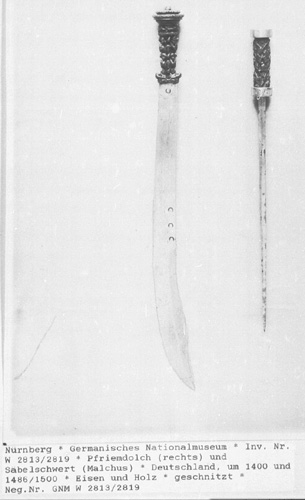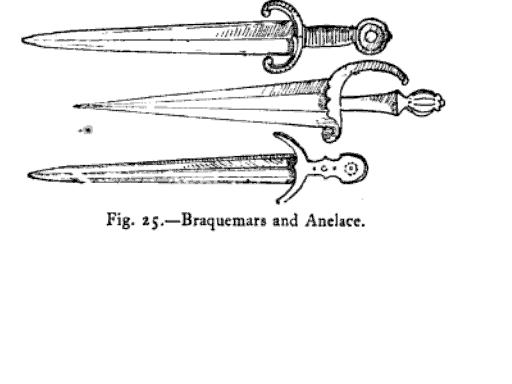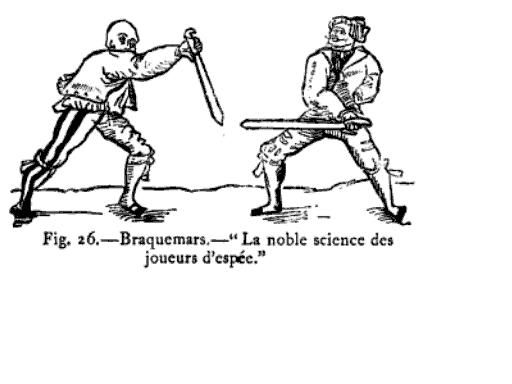can someone please direct me towards or provide me with a picture of a Braquemard or Malchus?
image searches have produced........... poor results....... as this is also apparently a slang term.
Hi Andy,
here's a Malchus from the Nationalmuseum Nürnberg. You can find a lot of these weapons on contemporary pictures of the 15th century - try this:
http://www.imareal.oeaw.ac.at/realonline/
Regards
Martin
 Attachment: 34.95 KB
Attachment: 34.95 KB

here's a Malchus from the Nationalmuseum Nürnberg. You can find a lot of these weapons on contemporary pictures of the 15th century - try this:
http://www.imareal.oeaw.ac.at/realonline/
Regards
Martin

Observation: Interesting term "Malchus." Haven't heard that before. Wonder if it is named based on reference to the Malchus who is described in the Gospels as a servant of the High Priest? His ear was cut-off by the Apostle Peter in the Gospels.
Hi GG,
yes, it is - on contemporary pictures you can often see Petrus cut of Malchus' ear with this kind of weapon.
Regards
Martin
yes, it is - on contemporary pictures you can often see Petrus cut of Malchus' ear with this kind of weapon.
Regards
Martin
i take it that the Wiki definition of it being a short broad strait double edge are incorrect then? or is the Braquemard functionally different?
In german "Malchus" is used as a synonym for "Falchion".
Interestingly, the apostle Peter is often shown using a messer like weapon in the paintings of the scene in the garden of Gethsemane. Again we see how the boundary between messer and falchion can be rather flexible at times.
I think this is an old use of the word, not a modern collector term.
I may be wrong. Perhaps some german speaking members can fill us in?
Interestingly, the apostle Peter is often shown using a messer like weapon in the paintings of the scene in the garden of Gethsemane. Again we see how the boundary between messer and falchion can be rather flexible at times.
I think this is an old use of the word, not a modern collector term.
I may be wrong. Perhaps some german speaking members can fill us in?
The term "Malchus" can be either used to describe a Messer or a Falchion in Germany.
I'm kind of surprised that this term is so unknown elsewhere than in Germany, because I always described a Falchion as a "Malchus" when I talked about it to german collectors, so I always thought that it was common....
But it's right, if I think about it, I've never read this term on english pages.
I'm kind of surprised that this term is so unknown elsewhere than in Germany, because I always described a Falchion as a "Malchus" when I talked about it to german collectors, so I always thought that it was common....
But it's right, if I think about it, I've never read this term on english pages.
| Peter Johnsson wrote: |
| In german "Malchus" is used as a synonym for "Falchion".
Interestingly, the apostle Peter is often shown using a messer like weapon in the paintings of the scene in the garden of Gethsemane. Again we see how the boundary between messer and falchion can be rather flexible at times. I think this is an old use of the word, not a modern collector term. I may be wrong. Perhaps some german speaking members can fill us in? |
Hi Peter,
"Malchus" is - as far as I know - one of the contemporary terms for this weapon. But keep in mind, that the people in the late medieval Germany used different words for the same weapons and vice versa - the terminology for different kinds of these weapons wasn't sharply defined.
The most common term was simply "Messer" - for that, what we call "Haus- or Bauernwehr" (= "Tsake" in the North of medieval Germany and "Rugger" in the South of medieval Germany & Switzerland), "Falchion" (that term was not common in medieval Germany), "Malchus", "Kriegsmesser/Zweihandsäbel" (these are modern terms) or "Langes Messer" today.
Regards
Martin
Thanks Martin,
I had got the imprerssion that Malchus was an old name for the category.
Knowing it is a pretty recent term makes it a less significant one: a matter of modern collector/curator terminology in the german cultural sphere, rather than something that tells us things about the original cultural history of the weapon.
Good to now :-)
Since the name has biblical connotations, it seems logical that the name was picked during a time period when bible studies were more important (or at least more common) than today. A 19th C name?
I had got the imprerssion that Malchus was an old name for the category.
Knowing it is a pretty recent term makes it a less significant one: a matter of modern collector/curator terminology in the german cultural sphere, rather than something that tells us things about the original cultural history of the weapon.
Good to now :-)
Since the name has biblical connotations, it seems logical that the name was picked during a time period when bible studies were more important (or at least more common) than today. A 19th C name?
the only source i could find about this, is L. & F. Funcken ( i do not know, how accurat they are, they often cite "oldtimers" as demmin and viollet-le-duc).
according to them a "malchus" is german for "baudelaire/bazelaire/basilaire" and could also be termed "sarrass",
a short, lightly curved saber
whereas a "braquemard" is described as largely the same, but with straight blade.
according to them a "malchus" is german for "baudelaire/bazelaire/basilaire" and could also be termed "sarrass",
a short, lightly curved saber
whereas a "braquemard" is described as largely the same, but with straight blade.
Hi,
interesting to see what "braquemard" meant. In modern French language (slang as Andy noted) it means something quite different :blush:
interesting to see what "braquemard" meant. In modern French language (slang as Andy noted) it means something quite different :blush:
| Peter Johnsson wrote: |
| Thanks Martin,
I had got the imprerssion that Malchus was an old name for the category. Knowing it is a pretty recent term makes it a less significant one: a matter of modern collector/curator terminology in the german cultural sphere, rather than something that tells us things about the original cultural history of the weapon. Good to now :-) Since the name has biblical connotations, it seems logical that the name was picked during a time period when bible studies were more important (or at least more common) than today. A 19th C name? |
Hi Peter,
the word "Malchus" isn't listed in Grimms "Handwörterbuch der deutschen Sprache" from 1838, but Wendelin Boeheim says in his "Handbuch der Waffenkunde" (Leipzig 1890, Page 270), that "Malchus" is the medieval(!) word for this weapon. I think, he's right, because illustrations of this weapon in the context of the captivation of Christ were very common in the late medieval Germany and everybody was familiar with the story of Petrus and Malchus at this time (and not just until the 19th century).
Regards
Martin
Martin, thanks for going back to text sources.
Inspired by you I looked myself in Heribert Seitz "Blankwaffen": he talks about the "Malchius-Falchion-Storta" group of weapons (and Seitz is here talking about the sword hilted weapon, not those blades of similar shape hilted as knives = messers).
(This was where I had my impression the name was of original use: I am sorry about being inexact and vague)
Heribert Seitz further tells that the naming of these weapons were in no way uniform during the medieval period, but varied between language regions.
In France weapons of this type (shortish, single edged blades of falchion form) were known as Badelaire, Baudelair, Bazelair and Braquemart, but also Fauchon.
The word "Fauchon" was used in England in the early 14th C and later developed into Falchion.
In Italy the type was known as Storta (or Stortina if it was of smaller size).
Seitz concludes the chapter on Falchions that in principle some larger "Messer" type weapons can be included in the group.
So perhaps we may draw the conclusion that "Malchus" was a word describing single edged, more or less curved weapons that could be hilted as knives or swords. The use of this word to describe the type has to do with popular depictions in art of the scene where Christ is captured in the garden of Gethsemane. That one name covered what we today recognize as two different types (sword hilted vs knife hilted) did not bother medieval people. It could be both the same thing and different: pretty normal procedure in the medieval world.
That later authors and historians give conflicting descriptions/definitions of what a Malchus or Braquemart looks like is not so strange as the design of these weapons also tended to vary between different areas. Especially Messer/Coltellaccio/Rugger/Ryting/Bauerwehr is an extremely varied group that mostly defies detailed, complete and uniform definitions.
Inspired by you I looked myself in Heribert Seitz "Blankwaffen": he talks about the "Malchius-Falchion-Storta" group of weapons (and Seitz is here talking about the sword hilted weapon, not those blades of similar shape hilted as knives = messers).
(This was where I had my impression the name was of original use: I am sorry about being inexact and vague)
Heribert Seitz further tells that the naming of these weapons were in no way uniform during the medieval period, but varied between language regions.
In France weapons of this type (shortish, single edged blades of falchion form) were known as Badelaire, Baudelair, Bazelair and Braquemart, but also Fauchon.
The word "Fauchon" was used in England in the early 14th C and later developed into Falchion.
In Italy the type was known as Storta (or Stortina if it was of smaller size).
Seitz concludes the chapter on Falchions that in principle some larger "Messer" type weapons can be included in the group.
So perhaps we may draw the conclusion that "Malchus" was a word describing single edged, more or less curved weapons that could be hilted as knives or swords. The use of this word to describe the type has to do with popular depictions in art of the scene where Christ is captured in the garden of Gethsemane. That one name covered what we today recognize as two different types (sword hilted vs knife hilted) did not bother medieval people. It could be both the same thing and different: pretty normal procedure in the medieval world.
That later authors and historians give conflicting descriptions/definitions of what a Malchus or Braquemart looks like is not so strange as the design of these weapons also tended to vary between different areas. Especially Messer/Coltellaccio/Rugger/Ryting/Bauerwehr is an extremely varied group that mostly defies detailed, complete and uniform definitions.
Yes, Peter - I totally agree with you.
Had the same problem, couldn't find ANY pictures or illustrations of one anywhere...these are from an old fencing manual.
 Attachment: 19.51 KB
Attachment: 19.51 KB

Illustration of Braquemars from ancient fencing manual
 Attachment: 23.44 KB
Attachment: 23.44 KB

Men fighting with Braquemars

Illustration of Braquemars from ancient fencing manual

Men fighting with Braquemars
Interesting how the bottom one looks like a cinquedea with a slightly narrower blade that most ?
None of the above look like single bladed messers, dussac or falchion but probably the messer fighting style(s) would be applicable to any large dagger/short sword when the blade is at least 15" long to maybe the 20" to 24" range ?
None of the above look like single bladed messers, dussac or falchion but probably the messer fighting style(s) would be applicable to any large dagger/short sword when the blade is at least 15" long to maybe the 20" to 24" range ?
This link (http://pendant.forumotion.net/manual-research-f13/la-noble-science-des-joueurs-despee-french-longsword-t81.htm) might be of some interest. it's a discussion of a french version of a German fight-book. In it the messer/dusack is called a "braquemard" .
@Jean: My understanding is the Braquemar(d) is a double-edged weapon...?
| Mark Jackson wrote: |
| @Jean: My understanding is the Braquemar(d) is a double-edged weapon...? |
Mark, welcome to the site and thanks for posting :D :cool:
No problem: But since the discussion has included the fencing system mentioned mostly single edged weapons I decide to sort of ask the question about the system being equally applicable to double edged weapons.
The are also so many " names " for what looks like very similar large dagger like anelace, coustille, braquemard, cinquedea that can get confusing ? Some are just regional names in different languages of the same thing, some may make subtle distinctions in type of weapon functionally or just aesthetically.
Some may be associated with a fighting system and the name given to the main weapon of the fighting system.
In some case the name is associated with the social status or bad reputation of professional soldiers/mercenaries as " coustillier " which can be a class of soldier or derogatorily associated with brigands, thieves, bullies or brawlers i.e. people of low reputation best avoided and feared by the general population as dangerous loose cannons during wars and even more between wars when they are unemployed.
Oh, the braquenard and the other weapons would also be in part the solution to the above problem since competence with weapons would make one a less tempting target and also be the weapon of the peaceful merchant, peasant or traveller I think. ( The above mostly just opinion and conjecture ).
Page 1 of 1
You cannot post new topics in this forumYou cannot reply to topics in this forum
You cannot edit your posts in this forum
You cannot delete your posts in this forum
You cannot vote in polls in this forum
You cannot attach files in this forum
You can download files in this forum
All contents © Copyright 2003-2006 myArmoury.com — All rights reserved
Discussion forums powered by phpBB © The phpBB Group
Switch to the Full-featured Version of the forum
Discussion forums powered by phpBB © The phpBB Group
Switch to the Full-featured Version of the forum